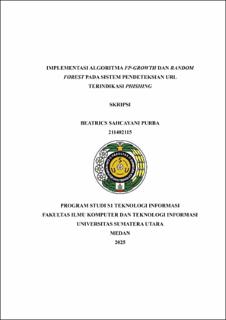Implementasi Algoritma FP-Growth dan Random Forest pada Sistem Pendeteksian URL Terindikasi Phishing
Implementation of FP-Growth and Random Forest Algorithms in A Phishing-Indicated URL Detection System

Date
2025Author
Purba, Beatrics Sahcayani
Advisor(s)
Nasution, Umaya Ramadhani Putri
Pulungan, Annisa Fadhillah
Metadata
Show full item recordAbstract
Phishing is a form of cyberattack that relies on fake URLs to lure users into sharing personal information or confidential credentials. This study aims to design a phishing URL detection system utilizing the Random Forest algorithm integrated with feature selection and feature engineering techniques based on the FP-Growth method. FP-Growth is utilized to select the most relevant features and generate feature combinations that frequently appear together in phishing data, enabling the model to focus on more complex patterns. The development process started with data preprocessing and checking, followed by feature selection and the creation of feature combinations, and then the construction of the Random Forest model. The system is implemented as a web interface using Flask and a browser extension to enable real-time phishing detection. In addition, a user feedback feature is provided and stored in a simple database to support evaluation and continuous improvement. The experimental results show that the Random Forest model achieved an accuracy of 96.51% on the testing dataset and 87% on real URL testing. The precision value of 93%, recall of 80%, and F1-score of 86% on real URL testing indicate that the system has a fairly good detection capability, although there are still some errors on URLs that closely resemble official URLs. With these results, the developed system is expected to serve as a practical and adaptive phishing detection tool that can be integrated into daily use and serve as a foundation for future research to address increasingly complex phishing attack patterns.
Collections
- Undergraduate Theses [873]
